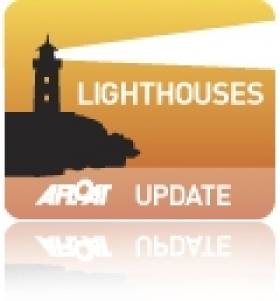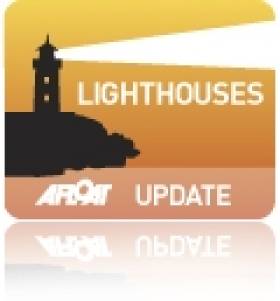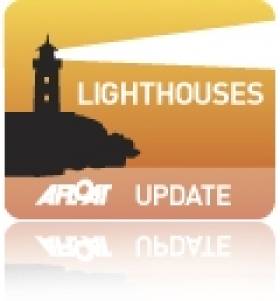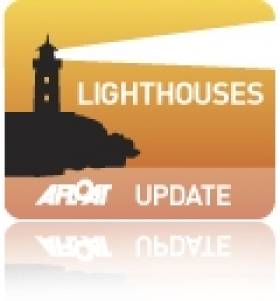Displaying items by tag: lighthouse
Loop Head Tourism Infrastructure Projects Completed
Clare County Council has completed two important tourism infrastructure projects in West Clare.
The projects at the Bridges of Ross and the West End Car Park in Kilkee cost €110,000 and €150,000 to complete respectively, and were both funded by Clare County Council and the Department of Agriculture, Food and the Marine.
The Bridges of Ross, a well known tourist location on the Loop Head Peninsula, has benefited from an upgrade to the local carpark and the surfacing of approximately 450 metres of access way. The works were carried out by Council staff supported by Oliver Keating Contractors and are aimed specifically at boosting marine tourism in the local area, which is renowned for its coastal geological features and marine life as well as being one of Ireland's best birdwatching locations.
Meanwhile, Council staff have completed a €150,000 resurfacing project at the West End car park in Kilkee providing additional car parking capacity for the popular tourist town.
"I very much welcome the completion of these small but very important schemes at two of Clare's most popular tourist locations," stated Mayor of Clare Cllr Joe Arkins.
He continued: "Both the Bridges of Ross and Kilkee, together with Loop Head and Carrigaholt feature strongly on the Wild Atlantic Way which is to be launched during 2014 and I have no doubt that visitors coming to these locations will appreciate the improved facilities that are now in place. The investments made on both of these projects reflect the Council's commitment to tourism and to continually building the tourism product in the rural parts of County Clare.
Siobhan Garvey, Marketing and Tourism Officer for West Clare said the improvement works complement the raised profile of the Loop Head Peninsula as a quality, accessible and sustainable visitor destination.
"The Loop Head Peninsula has become a very popular destination, as exemplified earlier this year when it won The Irish Times Best Place to Holiday in Ireland Award. I particularly want to acknowledge the Council for working with local communities and indeed, Loop Head Tourism in developing, managing and showcasing the wonderful tourism assets on offer at the Peninsula from Loophead Lighthouse to the Bridges of Ross to Kilkee Bay. I am sure with the additional flights to Shannon airport that numbers visiting the area will increase during 2014 and in future years," added Ms. Garvey.
Commenting on the completed works, Ms. Garvey stated: "The Bridges of Ross is a well known tourist location being one of the most scenic stops on the Peninsula. Many tourists and locals make their way to this location and previously, the facilities in place fell short of the required standards. The works undertaken ensure that adequate car parking is available and ensure that anyone wishing to see the Bridges of Ross can do so in a safe manner. As the Bridges of Ross is one of the main locations on the Wild Atlantic Way, Clare County Council will be installing interpretation to reflect the overall branding of the new tourist route."
"Meanwhile, the Council also has completed a resurfacing project at the West End car park in Kilkee. The availability of sufficient car parking facilities at the required standard is essential in a tourist town such as Kilkee and the upgrade works now provide a well surfaced and lined car park for use by those visiting Kilkee," she concluded.
Replacement of Crucial Eagle Island Atlantic Lighthouse by Helicopter Lift
#lighthouse – A challenging lighthouse redevelopment project has been completed on one of the most testing sites on the Irish Atlantic coast. The Commissioners of Irish Lights (CIL) has completed a re-construction and modernisation project at Eagle Island Lighthouse in Co. Mayo – a landmark lighthouse safeguarding Ireland's north-westcoast. The new light is being commissioned today.
This demanding project on Eagle Island consisted of the replacement of the entire upper part of the lighthousestructure using a helicopter. This is one of the mostchallenging construction projects undertaken by CIL in recent years.
Captain Robert McCabe, Director of the Operations and Navigation Services with CIL stated "Eagle Island lighthouse stands 220 feet above the Atlantic ocean, yetover the years waves from winter storms have damaged buildings and equipment in the walled lighthouse compound. Eagle Island lighthouse must provide a reliable and effective aid to navigation in extreme conditions because it is, at these times, when marinersmost require CIL aids. The new light on Eagle Island will provide a high quality, highly reliable 18 mile LED light and, for the first time, an automatic identification system. The solar battery system will remove the requirement for diesel generation with consequent environmental benefits and maintenance savings."
The Commissioners of Irish Lights (CIL) is actively involved in consolidating its coastal infrastructure which is the latest chapter in technology change that CIL is currently implementing; first came automation, then solarisation and now consolidation. The overriding purpose of consolidation is to provide a low-maintenance, low-energy, and low-cost Aids to Navigation service around the Irish Coast.
Eagle Island's unique location saw the establishment oftwo lighthouses on the island, both completed in 1835.Because of its close proximity to the continental shelfEagle Island experiences unusually large waves and over the years the lanterns have regularly been damaged by waves and water-borne rocks.
Due to these ferocious conditions, a huge storm wall was constructed surrounding the lighthouses. This wall was destroyed by the sea, reinforced and eventually abandoned after a particularly large storm in 1894 when it was decided to abandon the lower lighthouse.
The lighthouse keepers were withdrawn with the automation of the current lighthouse in 1988.
After almost 200 years of guiding mariners to safety, the lantern room and domed roof of the lighthouse tower had reached the end of their working life. The old lighthouse dome, the lantern room, the large glass lens and the bath of mercury in which the lens rotated were all removed. They were replaced with a stainless steel structuredesigned by CIL to withstand the aggressive and relentless marine environment.
This structure was manufactured by Shortt Stainless Steel in Limerick which incorporates a new roof, a guarded access platform and light pedestals. The roof also supports new waterproof and weather resistant flashing LED (light emitting diode) lights.
A temporary works system was also designed to access the previous dome for demolition works. This platformincorporated the means to manhandle heavy equipmentand the helicopter deck on which to land the new dome.Constructing all of this on top of the lighthouse tower was extremely challenging.
Commenting on the success of this unique construction challenge, Captain Robert McCabe of CIL stated "The CIL team who delivered this complex project have demonstrated exceptional engineering, planning and construction skills and made a positive contribution to safety at sea and the marine environment."
Spit Bank Lighthouse, Cobh, Cork Harbour Undergoes Maintenance Work
#spitbank – The Spit as it is known locally is one of the most well known and distinguished marks in Cork Harbour and greets every vessel passing between Whitegate and Spike Island heading upwards past Cobh writes Claire Bateman.
On passing the Spit last Sunday it was noticed the structure was covered from top to bottom with scaffolding. Two ships in attendance, obviously support vessels, for the ongoing work. One was called 'The Spit Bank' and the other 'The Spike Island'. Obviously renovation work is taking place and no doubt we will see a newly painted and gleaming structure emerge when the work has been completed.
Located to the to the south of Cobh, the Spit is set at the end of a long mud bank marking a ninety degree turn in the shipping channel. Its peculiar form and design make it a striking addition to the maritime heritage, as it differs greatly from the more traditional stone-built lighthouses which are found along the south coast.
The man behind this curious structure, Alexander Mitchell (1780-1868) was quite extraordinary. Born in Dublin, his family moved to Belfast while he was still a child and he was educated at the Belfast Academy where he showed great mathematical aptitude. His eyesight failed during his teenage years and he was blind by the age of twenty- three. Amazingly his blindness did not prevent him from becoming a pioneering self-taught engineer.
Mitchell patented the "Mitchell Screw Pile and Mooring' in 1833, a cast iron support system which allowed for construction in deep water on mud and sand banks. Apparently inspired by the domestic corkscrew, its helical screw flange c ould be used for difficult shifting foundations on a broad range of structures and its potential was realized in a broad range of projects: lighthouses in Britain and Ireland as well as more than 150 lighthouses in North America; piers such as in Courtown, Co. Wexford and the impressive pier at Madras, bridges and viaducts on the Bombay, Baroda and Central India Railway: and also for the telegraph network in India. Mitchell went on to apply the same technology to propellers and patented the screw propeller in 1854.
Lighthouses using this innovative system were built under Mitchell's supervision at Maplin Sands in the Thames Estuary in 1838; Wyre in Lancashire in 1840, Belfast Lough in 1853 and Dundalk in 1855. The foundations for the first lighthouse, Maplin Sands, were sunk in the incredibly short period of nine days. Before Mitchell's wonderful invention, floating lights had been used where a traditional lighthouse was not possible. Floating lights were not ideal as the movement of the light ship caused great variance in the light's location during storms, and floating lights could brake from their mooring, causing havoc for mariners.
An unlighted buoy had previously marked the commencement of the spit bank near Cobh, but Cork Harbour Commissioners required a more notable structure to take its place. Mitchell won the commission to construct the new lighthouse for £3,450, and moved with his family to Cobh (then Queenstown) in 1851, renting Belmont House overlooking the harbour. He immediately set about engaging workmen, testing the ground and examining the iron for the piles and wood for the house. His son and grandson laid the piles for the lighthouse, with regular inspections from Mitchell, while he oversaw the construction of a timber house on shore. During his fifteen months at Cobh, Mitchell took trips into Cork City during which he met with academic staff at the university and forged a friendship with the great mathematician, Boole. The light was exhibited for the first time two years later, while a foghorn was added in the 1890s. Set out to sea with no room for living accommodation, a principal and an assistant keeper lived in rented accommodation in Cobh.

The original drawings of Cork Harbour's Spit lighhouse. Image courtesy of Department of Arts, Heritage and the Gaeltacht
Incredibly, accounts survive of Mitchell personally overseeing construction, taking trips out to his lighthouses in small boats, even on rough seas and on occasion falling overboard, going up and down ladders, crawling along planks and examining the wood, iron and rivets. At times he rallied the workers' spirits, leading them in sea shanties. Through touch he checked the quality of the iron work, sometimes noting flaws which had escaped the workers' and foreman's eye. One worker is recorded as exclaiming 'Our master may say what he pleases, but I'll never believe that he can's see as well as thee or I'. Mitchell was made an associate of the Institute of Civil Engineers in 1837, and was elected a member in 1848, at which time he received the Telford silver medal for the invention of the screw pile. He was awarded the Napoleon Medal from the Paris Exhibition in 1855.
The Spit Bank Light Lighthouse remains an iconic structure in Cork Harbour. Described by some as a giant spider in the sea, its curious form and design has attracted much comment and curiosity for the past 150 years. Thanks to the endeavours of this truly gifted inventor and dedicated Engineer, countless lives have been saved at sea.
World's Oldest Lighthouse Hosts Keepers Global Gathering
#lighthouse – A global gathering of Lighthouse Keepers and enthusiasts will take place at the world's oldest lighthouse at Hook Head next weekend, September 13 to 15 and organiser's have today unveiled a fun filled programme of free events to keep families entertained.
Sunday, September 15 has been declared 'Sunday Fun Day' at the historic lighthouse, according to the manager Ann Waters everyone is invited to enjoy lots of entertainment. "Sunday is the day for free festival fun; we are looking forward to welcoming everyone to enjoy lots of fun entertainment, join in the singing of Sea Shanties with the Hooks and Crooks and enjoy the stiltwalkers and entertainers from Bui Bolg, the Claoimh Medieval Knights, games, face painting and lots more."
Sunday is the final day of the first gathering of Lighthouse keepers; festivities commence on Friday afternoon with a free open evening. Among those in attendance will be The Honourable Loyola Hearn, Canadian Ambassador to Ireland, Yvonne Shields, CEO of the Commissioners of Irish Lights and Larry O'Brien, Chair of Hook Heritage. Entertainment will be provided by the Wexford Male Voice Choir and soprano Emma Rochford.
On Saturday guests are invited to the Lighthouse Symposium 'If Lighthouses Could talk!' which will be hosted by former RTE News Anchor and Wexfordwoman Anne Doyle. Professor Kevin Whelan will offer an illustrated talk on Ireland in the Atlantic world focusing on mariners, merchants, migrants and light-keepers. Other speakers include guests from the Northern Lighthouse Board of Scotland and representatives from the Commissioners of Irish Lights and Newfoundland. The last principal Lighthouse Keeper and current Attendant at Hook Head Lighthouse, Tux Tweedy will attend, as well as several other former Lighthouse Keepers.
The weekend's highlight takes place on Saturday evening with drinks reception to be hosted in the historic cobbled yard at Hook Lighthouse with entertainment by Danescastle Traditional Irish Music Group and the Doyle Academy of Irish Dance. This will be followed by a Seafood Buffet and after-dinner entertainment provided by the Kennedy Sisters and traditional Irish music from Saolta. A fireworks display over the ancient landmark will bring this memorable evening to a spectacular close.
The global gathering of Lighthouse Keepers is being hosted in co-operation with the commissioners of Irish Lights and on behalf of past lighthouse keepers of Hook Lighthouse For further details see hookheritage.ie
Lighthouse Trail to Conserve Maritime Heritage of Ireland
The Commissioners of Irish Lights (CIL) are celebrating the launch of the first ever all-Ireland lighthouse tourism trail with Minister for Transport, Tourism and Sport Leo Varadkar and Arlene Foster MLA, Minister for the Department of Enterprise, Trade and Investement.
The launch will be held at Blackhead, Co. Antrim next Wednesday.
CIL are developing the lighthouse trail to preserve and conserve the maritime heritage of Ireland and re-invigorate an appreciation for lighthouses. The developments will see visitor facilities at every lighthouse on the trail allowing visitors to immerse themselves in the history of the site through Learning Zones, tours and even overnight in themed accommodation.
Loop Head Lighthouse Radio Club Make International Connections
#loophead – A group of amateur ham radio operators from Limerick, Clare, Kerry and Tipperary successfully managed to make contact from Loop Head Lighthouse with 350 other radio clubs throughout the world at the weekend.
The Limerick Radio Club broadcast non-stop for 48 hours from the West Clare lighthouse as part of the 16th International Lighthouse /Lightship Weekend (ILLW).
During the broadcast, visitors to the lighthouse were able to listen into communications with some of the other participating ham radio operators broadcasting from other lighthouses and lightships in 63 countries.
The club said it successfully made contact with lighthouses/lightships as far away as Brazil, Australia, Tonga, French Guiana, Asiatic Russia, Ecuador, The Azores and the US. Virgin Islands. The majority of all radio contacts were made with operators in the United States (200), Germany (155) and Italy (76). 61% of overall communication was conducted via radio with the remaining 39% being conducted via Morse Code.
Simon Kenny of the Limerick Radio Club commented: "The weekend was hugely successful from the perspective of raising the profile of Loop Head Lighthouse amongst radio operators from all over the world. We are delighted with the huge number of successful contacts made and look forward to developing our newly established relationships with other radio clubs in the coming months."
He added: "The attempt to bridge the Atlantic on 144MHz was unsuccessful. However, we consolidated and forged new friendships with our twinned club in South Jersey. They also responded to our attempt to communicate with them, while using the moon as a reflector. The conditions were not favourable for such an attempt but we learned a lot. It's the first time that the Limerick Radio Club has made such attempts and hopefully the next time will be successful - from Loop Head."
Clare County Council, along and the Commissioners of Irish Lights (CIL), has facilitated the broadcast from Loop Head Lighthouse by the Limerick Radio Club. The Club has also received approval from the Communications Regulator.
Gerard Dollard, Director of Services, Clare County Council described the International Lighthouse /Lightship Weekend as a "wonderful way to connect and promote the shared maritime heritage of countries throughout the world".
"We are delighted to have been able to lend our support to this initiative. In 2012, the Limerick Radio Club helped to further raise the profile of Loop Head Lighthouse through its conversations over the airwaves with fellow ham radio operators internationally. We wish the members of Limerick Radio Club the very best of luck over the weekend," added Mr. Dollard.
Further information on the annual International Lighthouse Lightship Weekend (ILLW) is available from www.illw.net
An amazing sea rescue, NAB-ing change, UK politicians support what Ireland’s will not, sailing in Galway and Mayo and much more in your TIN this week…
An amazing sea rescue, NAB-ing change, UK politicians support what Ireland's will not, sailing in Galway and Mayo and much more in your TIN this week.....
AMAZING SEA RESCUE
A 31-year-old seafarer has survived ten hours of swimming after ships in the Atlantic Ocean 525 miles offshore shouting to be rescued. It has been described as one of the most amazing sea survival and rescue stores. He fell off his ship after feeling faint when he leaned against a railing but blacked out, collapsed and fell overboard. The crew of the Maersk Bintan did not miss him for 2 hours after he had fallen off at 0715 hours. At that stage Tanawoot Pratoom, who came back to consciousness when he hit the water, had been swimming after ships he saw and shouting for help. The ships' crew had called a distress alert. Five vessels as well as a search-and-rescue plane were involved and the US Coast Guard was using drift simulation technology to locate his position. His own vessel doubled back on its course. He was spotted by another vessel involved in the search, the bulk carrier, Stalo. After ten hours he was pulled from the water by crewmates of his own ship. He said he had followed safety procedures by removing his boots and overalls in the water and had spent the ten hours swimming towards passing ships until he was sighted. His ship was en route from Panama to Algeciras where the seafarer was repatriated to his home in Thailand. He is married and has two children, an 8-year-old daughter and a three-month old son.
REFITTING THE NAB

The NAB Tower
The NAB Tower is a vital aid to navigation in the Solent but the structure has been deteriorating and is being restored by Trinity House, the UK lighthouse authority. It was originally built as a British defensive structure for the Admiralty in 1918 and has been used as a lighthouse since 1920 replacing the previous NAB Lightvessel. It was staffed by Lightkeepers until automation in 1983. At present the helicopter pad atop the lighthouse cannot be used and boat access has been difficult due to the deteriorating condition of the external superstructure. Trinity House is to extend the lifespan of the NAB Tower by up to 50 years. The height will be reduced and all external steel and cladding will be replaced by concrete. Work is scheduled to be completed in the summer of next year. It will be suspended during the winter due to difficult seasonal conditions.
YOLING IN GALWAY
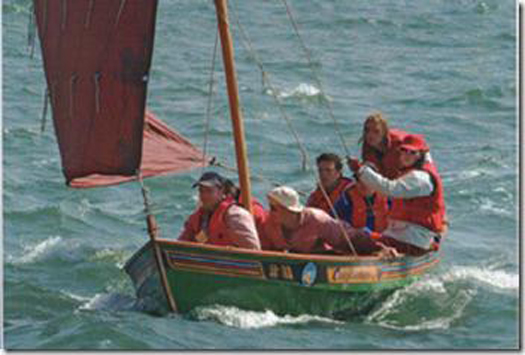
The Ness Yoal
The little beauty pictured here visited Galway Bay Sailing Club from France, but originated in Norway, were exported to the Shetlands and are now active in France, demonstrating the great linkage internationally through traditional sailing boats. The 'Yoling Club Peillac' is based in the village of Peillac, in South-East Brittany. It was created to promote traditional sailing amongst youth and especially the practice of navigation on the Ness Yoals, following the construction of three of these boats in 2000. The club aims to connect with other associations sharing similar interests in 'sail and oar' boats and to encourage the construction of traditional yachts and organises events to promote cultural heritage related to traditional sailing.
Ness yoals are wooden open boats of 6.90 m in length, rigged with a sail to the third of mahogany colour. The crew is composed of 7 people (six rowers and a coxswain). The Ness Yoals originated in Norway hundreds of years ago and were exported to the Shetland islands in Scotland, where it has a special place in the history of inshore fishing. It was considered a very seaworthy vessel and the seamanship of the men who crewed them, made the
difference between survival and starvation for many families there. Despite the development of commercial fishing, which favoured larger-decked boats, the Yoal has survived into the 21st century, due to the interest in Yoal-rowing as a sport and the craftsmanship of boat-builders like Tommy Isbister and Ian Best who still produce these craft.
UK POLITICIANS BACK SAIL TRAINING
Renowned naval architect Colin Mudie has designed a proposed new UK sail training flagship. Riding on the tide of successfully staging the Olympics and the Diamond Jubilee celebration a charitable trust has been set up called – UK Flagship – to promote the concept of a 650-foot tall ship which would be the largest and most advanced square-rigged vessel in the world. It is envisaged as a sail training ship with the additional role of being a 'floating ambassador' for the UK promoting trade and scientific research, with facilities aboard including conference rooms, oceanography and marine biological study resources and could carry up to 200 trainees. The cost is put at stg£80m., to be raised without State support. Launch of the ship is targeted for 2016 and stg£15m. has already been raised according to the backers, of which the Principal Trustee is Royal Navy Rear Admiral David Bawtree. UK sailing journalist Libby Purves is also involved in the project. The Daily Mail
Newspaper has launched a fundraising campaign for the vessel.
While not allocating any funding, leading UK politicians have pledged support and backed the project, showing at least an interest in sail training which their Irish counterparts lack. Deputy UK Prime Minister Nick Clegg said the project provided "a brilliant opportunity to promote the marine world and life at sea" while the UK Labour Party Leader, Ed Milliband, said it was a cause which deserved support because of its aim of "giving opportunity to youth."
The tall ship will feature four masts acting also as solar panels. Colin Mudie designed the sail training ships Royalist and Lord Nelson.
Operating tall ships is difficult in current economic times although the South African Government approved the conversion of a former research vessel by the country's Maritime Safety Authority to carry 50 cadets for sea training. The country has less than 2,400 seafarers and the government has adopted a policy to increase annual officer cadet intake for training which at present is 120 per year.
MAYO SAILING CLUB
When in Mulrany, Co.Mayo, this summer I enjoyed the idyllic view of Clew Bay and the 365 islands, one for each day of the year as local people proudly claim. Mayo Sailing Club was founded in 1982 and has this area as its immediate sailing grounds.
This is a thriving vibrant club, based at Westport, with a diverse range of sailing activities throughout the season - cruiser racing on Thursday nights, junior and senior dinghy racing on Tuesdays and cruising voyages.
Thirty-six trainee sailors from the club had an overnight sailing trip from Rosmoney Pier to Inishoo Island in Clew bay. It concluded the Adventure Module of the ISA Small Boat Sailing Scheme and also marked the end of the Junior Sailing course. The return voyage involved the trainees sailing a challenging beat home on a route through around many of the islands before arriving at Mayo Sailing Club.
FISHING LEADER HONOURED
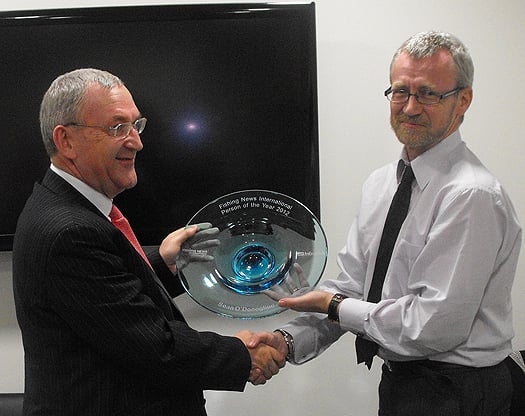
In London this week Sean O'Donoghue CEO of the Killybegs Fishermen's Organisation was presented with the Fishing News International magazine's Person of the Year award. The presentation was made by IntraFish Fishing Publications Editor Cormac Burke who is originally from Killybegs.
Loop Head Lighthouse Proves Major Tourism Draw
#lighthouse – Up to Monday (13 August 2012), 9691 adults and 2870 children had visited the historic West Clare landmark at Loop Head.
Clare County Council, along with Shannon Development, Loop Head Tourism and the Commissioners of Irish Lights (CIL), opened the 19th century lighthouse to the public for the second successive summer season in May. It is estimated that the 11-week trial opening scheme in 2011 was worth approximately €400,000 to the local economy.
Loop Head Lighthouse, located at the mouth of the Shannon Estuary, is steeped in history and rich in maritime heritage with its origins dating back to the 1670s. The existing tower style lighthouse was constructed in 1854 and was operated and maintained by a keeper who lived within the lighthouse compound.
Taoiseach Enda Kenny's grandfather was a keeper at the lighthouse. James John McGinley took up duty at the Lighthouse as Principal Keeper on 16th January 1933. He spent 1 year and 10 months at Loop Head. He was transferred from the station in October 1934. In January 1991, the lighthouse was converted to automatic operation, and today is in the care of an attendant and is also monitored by the CIL.
"The visitor figures are extremely encouraging and highlight the huge interest that exists amongst members of the public in Ireland's rich maritime heritage," explained Ger Dollard, Director of Services, Clare County Council.
He added: "The opening of the Lighthouse to the public has provided a significant boost to the local economy in the Loop Head Peninsula and wider West Clare region. The success of the project underlines the continued growth in the heritage tourism sector, as also evidenced by the recent reopening of Ennis Friary."
Mr. Dollard noted that the introduction this year of a new interpretative exhibition at Loop Head Lighthouse has helped to sustain the success of the trial opening scheme in 2011.
The exhibition, all materials and labour for which were sourced locally, focuses on the history of Irish lighthouses and the people who have operated them since the 17th century.
"With our project partners at Shannon Development, Loop Head Tourism and the Commissioners of Irish Lights (CIL), Clare County Council looks forward to the continued success of this project," Mr. Dollard concluded.
Loop Head Lighthouse will remain open to the public up to 3rd September 2012
Loop Head Lighthouse Hits the Air Waves
#lighthouse – Loop Head Lighthouse in County Clare will be amongst hundreds of lighthouses and lightships worldwide to participate in a unique event aimed at promoting public awareness of lighthouses and lightships and their need for preservation and restoration.
The Limerick Radio Club, comprising members from Limerick, Clare, Kerry and Tipperary, will broadcast non-stop for 48 hours from the West Clare Lighthouse on August 18-19th as part of the 15th International Lighthouse /Lightship Weekend (ILLW). During the broadcast, visitors to the lighthouse will be able to listen into communications with some of the other participating ham radio operators broadcasting from 400 other lighthouses and lightships in 50 countries.
The annual event, which is conducted under the sponsorship of the Ayr Amateur Radio Group (AARG) in Scotland, is always held on the third full weekend in August starting at 0001 UTC on Saturday and finishing at 2359 UTC on Sunday. It also coincides on the Sunday with International Lighthouse Day, an event organised by the Association of Lighthouse Keepers whereby many world lighthouses are open to the public for the day.
Ireland will be represented by Lighthouses at Loop Head (Clare), Roches Point (Cork), St John's Point (Down), Cromwell Point (Kerry) and Blacksod (Mayo).
Simon Kenny, Chairperson of Limerick Radio Club, explained: "The club, which was founded in 1946, has a long association with the Lighthouse Weekend and this year, for the first time, we are privileged to be allowed to operate from Loop Head."
Mr. Kenny added: "We hope to open long distance communications with regions in Asia, through Europe, North and South America, Australia and New Zealand. A special QSL Card (confirmation of communication) has been designed to mark the event. Club membership is open to individuals from all walks of life who are interested in radio communications, electronic construction and antenna design. The club will operate two stations, one of which will be at the entrance to the Lighthouse so members of the public can listen to some of the transmissions. Our web site is www.limerickradioclub.ie ."
Clare County Council, along with Shannon Development, Loop Head Tourism and the Commissioners of Irish Lights (CIL), has sanctioned the broadcast from Loop Head Lighthouse by the Limerick Radio Club. The Club has also received approval from the Communications Regulator.
According to Ger Dollard, Director of Services, Clare County Council: "We wish the members of Limerick Radio Club the very best of luck over the weekend. Their participation in this initiative helps to raise public awareness of Loop Head Lighthouse and other similar facilities across the world, while at the same time helps to promote amateur radio and to foster international goodwill."
Loop Head Lighthouse, located at the mouth of the Shannon Estuary, is steeped in history and rich in maritime heritage with its origins dating back to the 1670s. The existing tower style lighthouse was constructed in 1854 and was operated and maintained by a keeper who lived within the lighthouse compound. In January 1991, the lighthouse was converted to automatic operation, and today is in the care of an attendant and is also monitored by the CIL.
The Lighthouse has reopened to the public this summer, following a successful trial scheme in 2011 that resulted in an estimated 17,000 people visiting the landmark building.
New Archaeological Discoveries in Galway Bay
#GALWAY BAY NEWS - Archaeologists in Galway Bay have unearthed an extensive tidal weir complex at Barna and a late medieval quay on Mutton Island, The Irish Times reports.
The weir, which is estimated to date from the early Christian period, consists of a granite barrier with channels cut through it, designed to control the flow of water in the adjacent lagoon.
Connemara archaeologist Michael Gibbons suggests that the weir implies a considerable fish stock migrating through the area into the Barna river.
The remains of a large Iron Age fort which overlooks the site may also have given its name to the townland of Knocknacarra, which is now a populous suburb of Galway.
Meanwhile, further east at Mutton Island a medieval quay which predates the current lighthouse quay has been found.
The Irish Times has more on the story HERE.





























